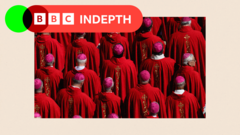The Vatican's Santa Marta guesthouse, which houses cardinals during the conclave, is set to come alive with discussions and debates starting May 7. Yet one suite remains untouched, sealed with a red ribbon since the passing of Pope Francis on Easter Monday. This symbolizes the weight of the legacy that the next pope must navigate—Francis reshaped the Catholic Church's priorities toward inclusive outreach and attention to global social issues.
In recent days, discussions among cardinals have revolved around building upon Francis's extensive reforms, yet a faction of critics continues to express reservations about continuing his ethos. This tension reveals significant divides as the Church attempts to unify its diverse global congregation, now more visible than ever with an unprecedentedly varied group of electors.
The upcoming conclave, consisting of 133 voting cardinals, will be marked by the presence of representatives from countries like South Sudan, Papua New Guinea, and Rwanda, emphasizing the Church's evolving global reach. These unprecedented inclusions may impact the conclave’s discussions, as issues pertinent to various regions come to the forefront. In Europe, the emphasis may be on revitalizing dwindling congregations, while African and Asian cardinals might focus on poverty and conflict.
The new pope will inherit a multifaceted role encompassing both spiritual leadership and political influence, as the Vatican’s global voice strives to resonate across different cultures. Recent meetings have highlighted the need for a leader who comprehensively understands both the Church’s administrative requirements and its calling to engage with broader societal matters.
As cardinals continue consultations leading to the vote, there remains a desire for clarity on the next steps for the Church, given confusion about the direction established by Pope Francis. His influential tenure engaged both believers and non-believers alike on pressing social issues. Yet, traditionalists contend with a perplexity around his intentions for Church governance, particularly regarding the shift of authority toward the laity.
Opposition voices, including some aged cardinals barred from voting, still seek to express their critiques of Francis’s vision. However, there’s growing acknowledgment of the importance of addressing contemporary social challenges, with many affirming that a strong response to global issues is crucial.
As the cardinals prepare to enter the Sistine Chapel amidst a backdrop of historical significance, the challenge remains to bridge their differences while maintaining continuity with the reforms Francis championed. The overarching theme has turned toward unity — attempting to build consensus on a vision that reflects the Church's mission in today's world, guided by both divine inspiration and practical realities.
Ultimately, as the time for selection draws nearer, cardinals will be urged to transcend their divide, perhaps urging the Holy Spirit to guide them toward the right choice for the future of the Catholic Church.






















